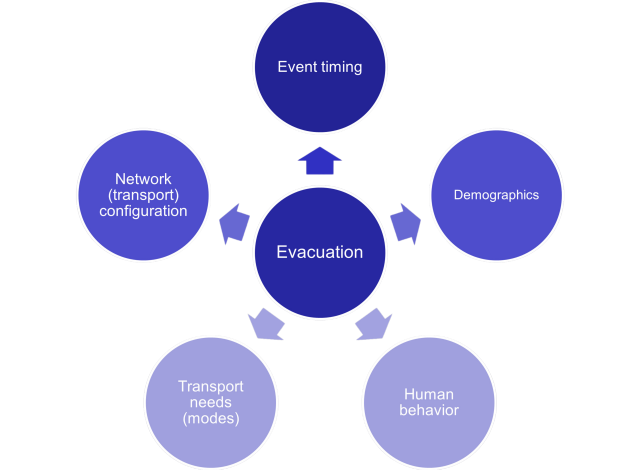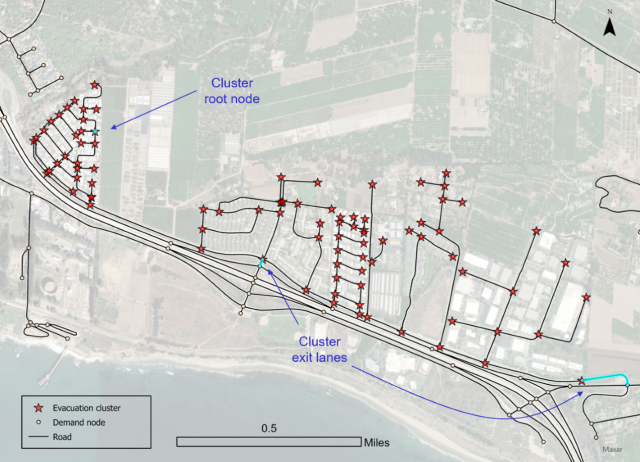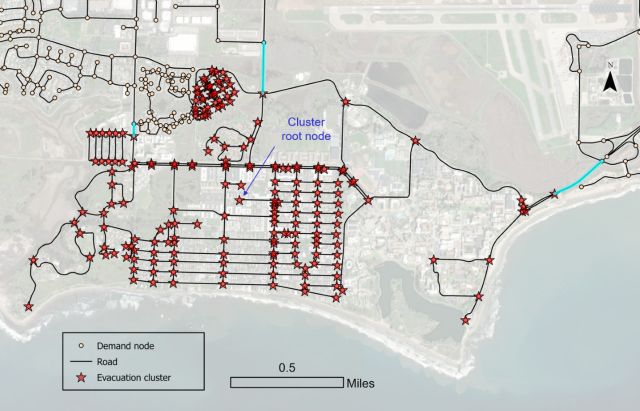
Evacuation Impacts
WRI researchers have developed spatial analytics to identify potential evacuation neighborhoods and their road exits in the Santa Barbara region. These neighborhood exits represent expected bottlenecks during a hazard evacuation event. The significance of these neighborhoods is based on their total residential population divided by the resulting number of exit lanes. The depicted neighborhoods therefore represent the highest ratios of population in the region.

We face a frightening range of hazards every day. While many threaten and/or impact large regions, most hazard events do not. Rather, they affect only a local area such as neighborhood or community. Many regions face almost daily evacuation orders for one or more neighborhoods. In such cases authorities, residents and visitors must know the time required to vacate a neighborhood, and where they need to go in order to escape danger. Evacuation then is the process of moving the fewest number of people necessary to the closest location(s) providing safety from the hazard.

Successful evacuation of an area requires planning and contingencies. An essential first step is identifying areas that may need to be vacated. Most counties have predefined evacuation zones that are generic in nature, often not specified on the basis neighborhoods nor any inherent spatial structure imposed by the transportation network. The reality, however, is that bottlenecks exist in the transportation system that limit egress (and ingress) and evacuation clearing time. Knowing these bottlenecks is important for ensuring traffic movement, and enables mitigation measures to be devised to ensure the effective and safe clearing of those in a threatened neighborhood or community. Such measures may include more lead time in issuing an evacuation order but also stationing first responders and/or emergency personnel to facilitate the flow of people out of an area. Additionally, infrastructure improvements and hardening to bottleneck segments may also be prudent.

Interactive Website
The interactive site displays evacuation clusters by their residential population divided by number of limiting exit lanes across the Santa Barbara region.
Methodology and Technical Details
Technical details and a description of the methodology are given in Murray (2024). The basic idea is identifying an area that is restricted in terms of evacuation capability. As an example, this map highlights portions of Isla Vista / UCSB, an area that has a population of 24,648. The indicated area has three single lane exits: Storke Rd (north of Sierra Madre Ct), Los Carneros Rd (north of Mesa Rd) and 217 (exiting UCSB). This gives an evacuation load of 8,216 people per lane (24,648 / 3), by far the highest observed in the Santa Barbara region.
Note that these are preliminary findings based on interpolated 2020 US Census block data. Further, we have observed irregularities in the associated transportation network data, so are actively working to correct them and report updated figures.
References
Murray, A.T. (2025). Critical neighborhood evacuation area identification. Journal of Transport Geography, 128, 104325.
Background Information
- Cova & Church (1997), Modelling community evacuation vulnerability using GIS. International Journal of Geographical Information Science, 11(8), 763-784
- Church & Cova (2000). Mapping evacuation risk on transportation networks using a spatial optimization model. Transportation Research Part C: Emerging Technologies, 8(1-6), 321-336.
Contact
